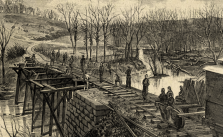Grand Tactician: The Civil War (1861-1865) – Readiness Guide
Readiness
All armies, corps, and fleets have a readiness rating, shown on the unit panel as welt as the unit’s NATO symbol on the map. Readiness is indicated using a color from high to low: green, yellow, orange, red. The rating shows how prepared the unit is to carry out your orders, taking into account the commander’s judgment. Placing the mouse cursor on the color bar in the unit panel will show further information about the effects of current readiness and the estimated time it takes to reach full readiness.
Readiness is consumed when the unit is operating and recovers when the unit is resting. Each step of readiness (color code) below green introduces the following restrictions:
Yellow: Unit cannot use forced march.
Orange: In addition, the unit cannot be ordered to carry out offensives in enemy territory. Army/fleet orders are unavailable.
Red: The unit cannot use an offensive stance or construct anything in addition to all the above.
Additionally, movement speed is reduced depending on the unit’s readiness, and order and reinforcing delays are increased. Units with high readiness will have a greater command and combat range, allowing them to intercept enemies or reinforce battles from a longer distance. In short, units with low readiness will react and move slower, and cannot carry out offensives in enemy territory. It’s crucial to rest your armies before major operations. Suppose you try to give a new movement order into enemy territory when readiness is low (orange, red). In that case, you will receive information about the commander not carrying the order out due to the low readiness of his unit. You may give movement orders to any unit in friendly territory. If the unit is engaged
Readiness Consumption
Readiness is consumed when the unit is moving. The rate of consumption depends on the support of the. State the unit is moving through. If state support is low, the unit will need to use further effort to scout, cover its movement, set up garrisons, and manage the lack of support from local citizens. Readiness consumption also depends mainly on the commanding. Officer. A cautious officer will consume readiness much faster than an aggressive one (initiative attribute). Transporting the unit using railroads or ships will cost additional readiness, as will bad weather and winter.
When recruiting or transferring new brigades to the unit, readiness will decrease slightly, as further reorganization is required. The same is true when changing the commanding officer. The new commander will need to organize his staff and get to know his troops and officers before considering the unit ready for offensives. Combat and casualties will also consume readiness.
Readiness Recovery
Readiness is recovered whenever the unit is not moving or engaged. When recovering, the organizational skills of the commanding officer are needed. For this reason, units with a commander skilled in administration will recover from low readiness faster. Smaller units will also recover more quickly than large ones. The size is calculated from the number of brigades or ships.
The following conditions will influence the speed of recovery negatively:
– Poor supply rating,
– Number of units/ships that have not yet arrived,
– Low morale,
– Bad weather,
– Poor intelligence gathering,
– Low training of the troops,
– Winter quarters,
– Siege combat.











